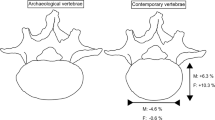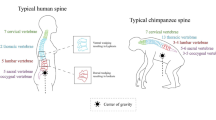Abstract
Nowadays, lumbar spondylosis is one of the most frequent causes of lower back pain. In order to improve our understanding of the lumbar spine anatomy and functionality over time, we compared the lumbar vertebrae of Neanderthals with those of anatomically modern humans. The fossil record reports on only two Neanderthal skeletons (i.e., Kebara 2 and Shanidar 3, both predating the appearance of modern humans) with full preservation of the entire lumbar spine. Examination of these early hominids showed that they display natural lumbar kyphosis, with only mild degenerative changes of the lumbar spine (ages at death: 30–35 years, Kebara 2; and 35–50 years, Shanidar 3). This finding is highly unexpected since Neanderthals are known to have had extraordinary physical activity due to demanding living conditions. The adult lumbar spines discussed here therefore show no correlation between high physical activity and degenerative spine disease as known from recent times. We speculate that both the kyphosis itself and the massive and heavily muscled skeleton of Neanderthals are causative for the minimal bone degeneration. We conclude that a kyphotic lumbar spine is the natural anatomy in these two Neanderthal individuals. Future research will reveal if this holds true for the entire Neanderthal species.


Similar content being viewed by others
References
Aeby C (1879) Die Altersverschiedenheiten der menschlichen Wirbelsäule. Arch Anat Physiol 10:77
Arensburg B, Bar Yosef O, Chech M, Goldberg P, Laville H, Meignen L, Rak Y, Tchernov E, Tillier AM, Vandermeersch B Une sépulture néanderthalien dans la grotte de Kebara (Israel) (1985) Compte Rendus des Séances de l´Académie des Science (Paris), Série II 300:227–230
Arensburg B (1991) The vertebral column, thoracic cage and hyoid bone. In: Bar Yosef O. and Vandermeersch B. Le Squelette Mousterian de Kebara 2:113–146. Editions du C.N.R.S. (Paris)
Berry JL, Moran JM, Berg WS, Steffee AD (1987) A morphometric study of human lumbar and selected thoracic vertebrae. Spine 12(4):362–367
Crubézy E, Trinkaus E (1992) Shanidar 1: a case of hyperostotic disease (DISH) in the middle Paleolithic. Am J Phys Anthropol 89:411–420
Ismail AA, Cooper C, Felsenberg D, Varlow J, Kanis JA, Silman AJ, O'Neill TW, study group (1999) Number and type of vertebral deformities: epidemiological characteristics and relation to back pain and heigh loss. Osteoporos Int 9:206–213
Jackson RP, McManus AC (1994) Radiographic analysis of sagittal plane alignment and balance in standing volunteers and patients with low back pain matched for age, sex, and size. Spine 19:1611–1618
Lane NE, Bloch DA, Jones HH, Marshall WH, Wood PD, Fries JF (1986) Long-distance running, bone density, and osteoarthritis. JAMA 255:1147–1151
Ogilvie MD, Hilton CE, Ogilvie CD (1998) Lumbar anomalies in the Shanidar 3 Neandertal. J Hum Evol 35:597–610
Panush RS, Schmidt C, Caldwell JR, Edwards NL, Longley S, Yonker R, Webster E, Nauman J, Storck J, Pettersson H (1986) Is running associated with degenerative joint disease? JAMA 255:1152–1154
Rak Y, Arensburg B (1987) Kabara 2 neanderthals pelvis: first look at a complete inlet. Am J Phys Anthropol 73(3):227–231
Trinkaus E (1985) Pathology and the posture of the La Chapelle-aux-Saints Neanderthal. Am J Phys Anthropol 67:19–41
Trinkaus E (1995) Neanderthal mortality patterns. J Archaeol Sci 22:121–142
Valladas H, Joron JL, Valladas G, Arensburg B, Bar-Yosef O, Belfe Cohen A, Goldberg P, Laville H, Meignen L, Rak Y, Tchernov E, Tillier M, Vandermeersch B (1987) Thermoluminescence dates for the Neanderthal burial site at Kebara in Israel. Nature 330:159–160
Van Saase JLCM, Van Romunde LKJ, Cats A, Vandenbroucke JP, Valkenbrug HA (1989) Epidemiology of osteoarthritis: zoetermeer survey. Comparison of radiological osteoarthritis in a Dutch population with that in 10 other populations. Ann Rheum Dis 48:271–280
Videman T, Battié MC (1999) The influence of occupation on lumbar degeneration. Spine 24:1164–1168
Weber J, Czarnetzki A, Spring A (2003) Paleopathological feature of the cervical spine in the early middle ages: natural history of degenerative diseases. Neurosurgery 53:1418–1424
Zhou SH, McCarthy ID, McGregor AH, Coombs RRH, Hughes SP (2000) Geometrical dimensions of the lower lumbar vertebrae—analysis of data from digitised CT images. Eur Spine J 9:242–248
Acknowledgments
The authors are grateful to Yoel Rak at the Department of Anatomy and Anthropology, Sackler School of Medicine, Tel-Aviv University, Tel-Aviv, Israel, for the invitation to examine the Neanderthal skeleton termed Kebara 2.
Conflict of interest statement
None of the authors has any potential conflict of interest.
Author information
Authors and Affiliations
Corresponding author
Rights and permissions
About this article
Cite this article
Weber, J., Pusch, C.M. The lumbar spine in Neanderthals shows natural kyphosis. Eur Spine J 17 (Suppl 2), 327–330 (2008). https://doi.org/10.1007/s00586-008-0640-y
Received:
Revised:
Accepted:
Published:
Issue Date:
DOI: https://doi.org/10.1007/s00586-008-0640-y




